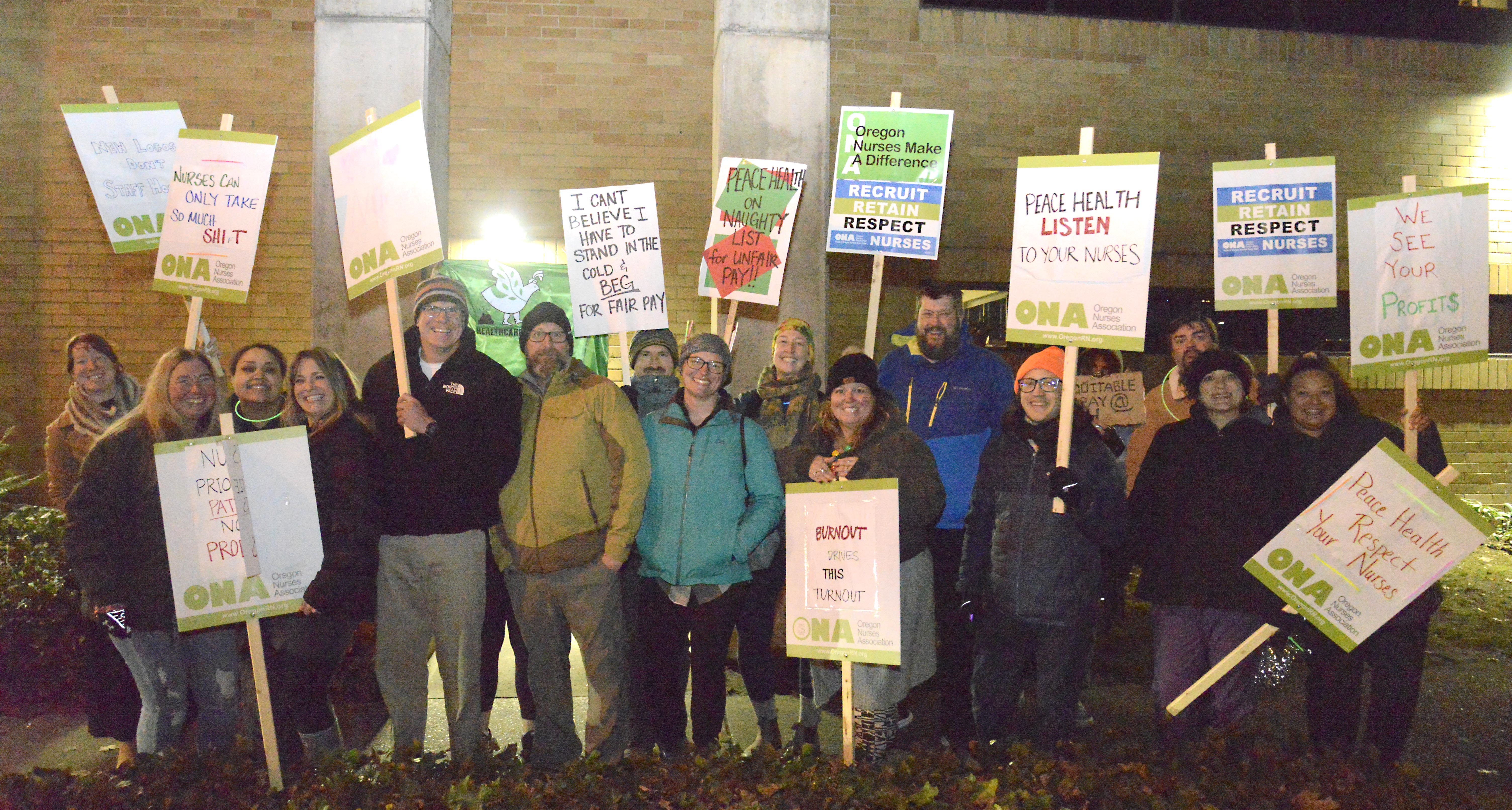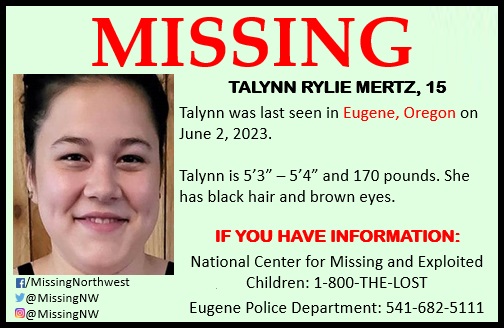The latest news stories and stories of interest in the Willamette Valley from the digital home of Southern Oregon, from Wynne Broadcasting’s WillametteValleyMagazine.com
Wednesday, February 7, 2024
Willamette Valley Weather

4J School District Superintendent Being Investigated
Eugene School District 4J Superintendent Andy Dey is facing an investigation into allegations of discrimination and retaliation against a school employee, according to sources familiar with the investigation.

The investigation, which began in fall 2023, includes other allegations of misconduct involving Dey, sources familiar with the investigation say.
The investigation report by a Seattle law firm is now in the hands of the Eugene District 4J School Board. School board members must now decide whether the evidence would prompt disciplinary actions against Dey.
Eugene Weekly’s request for comment from Dey went unanswered. EW reached out to Dey’s chief of staff, Jenna McCulley, and to a district spokesperson but did not receive a response.
Dey narrowly won appointment by the school board as superintendent 18 months ago after a fraught debate. He has worked in education and in the 4J district for more than 20 years, as a teacher, principal and administrator.
As a finalist for the top job, Dey faced criticism and complaints that he used bullying tactics, especially toward female employees, while serving as a 4J administrator. Reporting by KEZI-TV at the time brought the allegations to light.
Despite the concerns about Dey, the board voted 4-3 to hire him in June 2022. 4J did not respond to a question about Dey’s salary but media reports show the previous superintendent had a base salary of $241,500 when he left in 2020.
Since Dey’s appointment, there’s been plenty of board turnover — five of the seven school board seats have changed hands, thanks to recent elections and a resignation.
Several current and former district employees reached by EW declined to comment on record about the investigation, citing fears of retaliation. It’s not clear what the board’s members will do with the investigation into Dey. (SOURCE)
02/03/24 – LCSO Case #24-0566 – LCSO K9 Bruno Assists Arrest

On Saturday evening, deputies responded to a report of a kidnapping in the 80100 block of Highway 99 near Saginaw. A deputy located the involved vehicle and initiated a traffic stop. He recognized the suspect, Jason Searles, in the back seat. Deputies were aware of Searles from past calls for service, including an arrest that required the Sheriff’s Office Special Response Team.
Searles refused to comply with deputies’ instructions to exit the vehicle, and began moving around in the back seat as though looking for something. Concerned for the safety of the occupants of the vehicle and by Searles refusal to cooperate, Deputy Thomas deployed LCSO canine Bruno to the vehicle. Bruno was able to apprehend Searles and assist with removing him from the vehicle. Searles then complied with being detained before struggling again.
Deputies were unable to confirm a kidnapping occurred. However, Searles was arrested for Harassment, Failure to Report as a Sex Offender, Interfering with a Peace Officer, Resisting Arrest, and a Parole Violation.
The Lane County Sheriff’s Office K9 Unit is funded by community donations. All donations go directly to the K9 program to supply food, veterinary care, and equipment. Learn more at https://www.lanecounty.org/government/county_departments/sheriff_s_office/about_us_-_now_and_then/police_services_division/k9_unit
Salem Barber Arrested in Sex Crimes Investigation
Detectives seek other potential victims
Salem, Ore. — Salem Police Special Victims Unit detectives arrested a local barber in connection with a sex crimes investigation.
Eron David Griffin, age 42 of Salem, became the focus of an investigation that began in October 2023 after teen victims reported being subjected to sexual contact during visits with him. Griffin was subsequently arrested on several charges, including three counts of third-degree sexual abuse and commercial sexual solicitation.
Based on the investigation, detectives suspect there may be other minors who were victimized by Griffin who ran the barbershop from his residence. Anyone who has had similar incidents involving Griffin, or who may have information relevant to the case, is asked to contact Detective Sabrina Hunter at 503-540-2443.
Police Searching For Gunman In Cottage Grove Shooting
Cottage Grove Police are searching for a gunman and driver that left the scene of a shooting at Harvey Road and Gateway Blvd. at 6:05 p.m. on Jan. 31.
According to Chief Cory Chase, police arrived to find 22-year-old Jacob N. Roberson of Cottage Grove had been shot at least once. He was transported to the local hospital with non-life-threatening injuries.
“The information we have is that the shooter and several accomplices fled the scene in what is described as a white or tan domestic sedan prior to police arriving,” Chase said.
The preliminary investigation revealed a group of people were involved in a physical fight related to an on-going dispute. During the fight, the suspect fired several shots at the victim, striking Roberson at least once.
“We don’t have any additional information about the dispute right now,” Chase said. “It’s still early in the investigation.”
Roberson is expected to recover from his injuries. According to the report, the Cottage Grove Police Department is operating on the idea this is an isolated incident between two individuals known to each other and there is no immediate threat to public safety at this time.
Cottage Grove Police Officers were assisted by Deputies with the Lane County Sheriff’s Office.
Anyone with additional information about this incident should contact the Cottage Grove Police Department at (541) 942-9145.
Roadside Cleanup Work Continues On Hwy 126 In Western Lane County

Travelers on Highway 126 between Eugene and the coast will see delays for the next few weeks as crews continue clearing debris created by January’s ice storm.
Over the last two weeks, crews of Oregon Department of Transportation staff and contractors have been working to remove downed trees and other storm debris from the roadway and surrounding area. While a lot has been done to clean up the highway and make it safer, ODOT spokesperson Mindy McCartt said there is still more to be done.
“The trees in that area, they’re guesstimating the diameter is about 36 inches, and that’s a lot of hard wood,” she said. “It takes a long time to clear that kind of debris up.”
The highway itself is clear of limbs, McCartt said, but their focus is on cleaning up tree stumps and logs on the edge of the highway to the tree line.
According to McCartt, the department saw the most damage at Knowles Creek Tunnel, which is the starting point for two teams performing the clearing work. One smaller crew is performing work from the tunnel west toward the coast. The other, larger crew is working in increments eastbound on the highway, clearing sections of the road toward Veneta.
“They’re also having to assess and evaluate all of the trees along that highway for any potential damage or danger,” she said. “So cracked trunks, dangling limbs, trees leaning over toward the direction of the highway that could potentially fall if we got more wind.”
Once the crews are finished, they will do the same work on Highway 36. McCartt said the road is already clear, but trees off to the side also need to be assessed.
However, it may take a while before that work gets started.
“We are estimating that on 126 alone, we have another five weeks to get this tree debris cleaned up from the edge of the highway to that tree line,” McCartt said.
Lane Co. Government – Residents asked to fill out ice storm damage assessment form online
Lane County residents whose homes were damaged in the recent ice storm are being asked to fill out an online damage assessment form.
English: https://www.cognitoforms.com/LaneCountyOR/LaneCountyIceStormHousingDamageSurvey

Spanish: https://www.cognitoforms.com/LaneCountyOR/EncuestaSobreLosDa%C3%B1osMateriales

Both renters and property owners are encouraged to complete the form. The form will be used to help Lane County and its partners understand the long-term recovery needs of the community.
People should still work with their insurance companies to pursue reimbursement for eligible damages and repairs. There are currently no government resources available to repair private properties or businesses.
Nurses File Unfair Labor Practice Against PeaceHealth for Threatening to Cut Workers’ Health Insurance

PeaceHealth Continues Refusing to Meet with Nurses after Canceling Scheduled Mediation
(Eugene, OR) – The Oregon Nurses Association (ONA) has filed an unfair labor practice charge alleging PeaceHealth executives responded to a strike notice by threatening to terminate health insurance for home care nurses and their families throughout Lane County. While nurses from PeaceHealth Sacred Heart Home Care Services remain willing to meet while preparing to picket PeaceHealth Feb. 10 – 24; PeaceHealth executives have refused to sit down with nurses and made plans to cut workers’ health insurance.
After receiving nurses’ original strike notice Jan. 19, PeaceHealth executives told workers it planned to terminate striking nurses’ health insurance along with any covered family members—including people with chronic health conditions or disabilities. Threatening to cut its own workers’ health insurance in retaliation for engaging in protected activities is a clear violation of federal law. The National Labor Relations Act prevents companies like PeaceHealth from threatening, punishing or retaliating against workers who engage in protected union activities including strikes.
“Even after everything PeaceHealth has put this community through over the last few years, threatening to cut its own nurses’ health care is a new low. This is a direct attack on local health care professionals and their families,” said ONA President Tamie Cline, RN. “Shame on the executives running PeaceHealth for putting profits before patients and the nurses who care for them. Why would anyone in this community trust PeaceHealth to provide health care for them when PeaceHealth refuses to provide health care for its own workers?”
The ULP states PeaceHealth broke federal law and its own internal policies by threatening to punish and retaliate against workers and their families for striking. The National Labor Relations Board adjudicates ULPs and can impose financial and legal penalties on companies like PeaceHealth which break federal law. The board is expected to open an investigation into PeaceHealth’s conduct.
“PeaceHealth has a bad reputation for threatening its own workers’ health care. While we are deeply disappointed PeaceHealth threatened to terminate health insurance for local nurses and their families at PeaceHealth Sacred Heart Home Care Services—we were not surprised,” said ONA spokesperson Kevin Mealy. “Nurses are willing to sacrifice to make sure everyone in this community receives the care and respect they deserve and we’re prepared to ensure nurses and their families continue to have access to health insurance throughout this strike regardless of the dates.”
While nurses have offered to continue negotiating with PeaceHealth to try to reach a fair agreement and prevent a strike, PeaceHealth executives canceled their Jan. 23 meeting with nurses and a federal mediator and have refused to meet with frontline nurses since. PeaceHealth’s refusal to meet with nurses and bargain in good faith also violates the National Labor Relations Act.
Local home care nurses are striking to protect community health and safety and address PeaceHealth’s staffing crisis. The strike runs Saturday, Feb. 10 at 7 a.m. to Saturday, Feb. 24 at 7 a.m. outside PeaceHealth’s Sacred Heart Home Care Services Springfield office (123 International Way, Springfield, OR) Nurses will hold a kickoff rally Sat. Feb. 10 at 10 a.m. and invite community members to participate in the kickoff rally and join nurses on the picket line each weekday from 7 a.m. to 7 p.m.
- Visit RespectOurNurses.com to learn more.
The Oregon Nurses Association (ONA)is the state’s largest and most influential nursing organization. We are a professional association and labor union which represents more than 18,000 nurses and allied health workers throughout the state, including more than 90 nurses at PeaceHealth Sacred Heart Home Care Services and nearly 1,500 frontline nurses at PeaceHealth Sacred Heart Medical Center. ONA’s mission is to advocate for nursing, quality health care and healthy communities. For more information visit: www.OregonRN.org.
Operation Winter Survival Supply Stockpile Drive Need Ongoing

Lane County Health & Human Services, in partnership with the First Christian Church of Eugene’s Helping Hearts program and White Bird, today announced the launch of Operation Winter Survival Stockpile. The operation is an effort to create a stockpile through donations of clothing and other supplies that will help those in our community experiencing homelessness better brave the elements.
Items can be dropped off on weekdays between 10 A.M. and 2 P.M. or by appointment. Items can also be purchased on Amazon and sent to First Christian Church at 166 Oak St. Eugene, OR, 97402.
The Operation’s Amazon Wish List can be found at: https://www.amazon.com/hz/wishlist/ls/2XR33GS1ULV8Z?ref_=wl_share
Distribution of items will be prioritized to homeless outreach providers such as CAHOOTS that come into direct contact with individuals who are unhoused and unsheltered. Preferred donation items include:
- Clothing such as rain ponchos, wool socks, thermal underwear, gloves, beanies and footwear
- Items like tents, blankets, hand warmers, tarps, gift cards, and laundry cards
- Tools such as flashlights, batteries, and other survival supplies
For more information on Operation Winter Survival Stockpile, please contact Maria Cortez at ia.Cortez@lanecountyor.gov“>Maria.Cortez@lanecountyor.gov

Guide to The 2024 Oregon Legislative Session
Oregon lawmakers headed to Salem early Monday morning for the start of a 35-day sprint to pass budget fixes and bills addressing some of the most pressing issues facing the state.

Along the way, they’ll want to hear from Oregonians about how they should vote and what issues they should prioritize. Here’s a guide on engaging with the Legislature:
The basics – Oregon’s Legislature has 90 members, 60 in the House and 30 in the Senate. State representatives are up for election every two years, while senators serve four-year terms.
Democrats control both the House and the Senate, with 35 Democrats in the House and 17 in the Senate. Gov. Tina Kotek is also a Democrat, and, in general, Democrats are able to pass most bills into law without needing Republican support though a three-fifths majority, or 60%, is needed to pass revenue-raising bills. Still, most proposals are supported by both parties. The state constitution requires 40 House members and 20 senators be present to do any business. That unusual law allows Republicans to shut down the Legislature by walking out, as Senate Republicans did for six weeks last year.
Some states have full-time legislatures, but Oregon’s is part-time. Most lawmakers have other jobs.
In odd years, lawmakers meet for up to 160 days. They pass hundreds of laws and approve the state’s budget for the next two years. In even years, they meet for 35 days to tackle any pressing issues or fixes to the budget.
How do bills become law? — Every representative and senator can introduce two bills this year. Committees introduce other bills. Most are now posted online.
Because of last year’s Senate walkout, bills now come with a short digest explaining in simple language what the bill would do.
Each bill is assigned to a committee, and the committee’s chair schedules public hearings for bills they think should be considered. The committee holds hearings on bills, usually followed by a work session to decide whether the bill needs amendments and whether it should move forward.
Bills that carry a fiscal note, meaning they’ll cost the state money, go to the Ways and Means Committee. Others can go to the full House or Senate, and the speaker or Senate president decides whether they should be scheduled for a vote. A bill that passes one chamber starts the process over again in the other.
If both the House and the Senate pass a bill, it goes to Kotek, who can sign it into law or veto it.
How can I weigh in? — You can always email or call your representative and senator. Contact information can be found here for the House and here for the Senate. If you don’t know who your representative or senator is, you can find out by searching with your address here.
You can also speak to a committee about a bill during a public hearing or provide written testimony up to 48 hours after a public hearing concludes. Find instructions for submitting testimony online here.
Visiting the Capitol — Most of the Capitol has been closed for nearly two years and will remain closed for another year because of an ongoing nearly $600 million construction project intended to prepare the historic building to weather seismic activity, upgrade dated electrical and plumbing systems and comply with the Americans with Disabilities Act.
The House and Senate chambers, one hallway with six hearing rooms and legislative offices remain open. Visitors can enter through an entrance on State Street across from Willamette University and will go through security. They’ll see elevators to the House chamber and offices down the hall on the left and to the Senate chamber and offices on the right.
There are metered parking spaces near the Capitol and parkades and three-hour on-street free parking a few blocks away in downtown Salem.
Visitors can watch lawmakers debate bills in the House and Senate from galleries on the third floor. They can also sit in the audience for committee hearings, and overflow rooms may be available for widely-attended hearings. Hearings can also be watched online. Links are posted under the committee name and appropriate date. To find a meeting for this session, go to the calendar for the 2024 regular session, find the appropriate day and click through to the appropriate hearing. (SOURCE)
Rural Property Owners Are About To Be Subject To New Wildfire Regulations
In the wake of a series of devastating wildfires across the western United States, several states have made significant changes to their state wildfire programs. After the 2020 Labor Day Fires, Oregon joined suit. In 2021, the Oregon Legislature adopted SB 762, which provided more than $220 million to help Oregon modernize and improve wildfire preparedness.
Oregon’s new program is based on three key strategies: creating fire-adapted communities, developing safe and effective wildfire response, and increasing the resiliency of Oregon’s landscapes.
Implementation of SB 762 got off to a rocky start with the roll-out of the state’s wildfire map. As a result, the legislature enacted SB 80 in 2023, which made significant changes to the map and mapping processes. The two bills combined change Oregon law in a way that will directly impact property owners, yet few Oregon property owners are aware of the pending changes. We think that needs to change.
Here is what you can anticipate from Oregon’s new wildfire programs:
Wildfire Programs Advisory Council will oversee implementation. — 2024 is set to be a significant year for Oregon’s wildfire program, and the Wildfire Programs Advisory Council (WPAC) will be deeply involved. WPAC is a 19-member Council appointed by Oregon legislative leaders to advise both the Oregon legislature and Governor Kotek on Oregon’s wildfire program – its strengths, weaknesses, and areas for improvement. I was honored in September to be chosen by my fellow council members as the incoming Chair of the WPAC.
The role of WPAC is to serve as the voice of the public on Oregon’s wildfire program. In fact, both Sam and I serve on the council – Sam as the representative of Oregon’s agriculture community and me as the representative for Oregon’s rural residential property owners. The Council meets four times a year, and in special meetings when needed. Our meetings are conducted virtually and are open to the public. Public participation is encouraged and welcomed. (READ MORE)
Legacy Health takes action to ensure Regence BlueCross BlueShield members have access to quality, financially sustainable care close to home
Legacy seeks fair, reasonable and competitive increase in reimbursement.
Portland, Ore. (Feb. 6, 2024) — Legacy Health recently issued a notice of contract termination with Regence BlueCross BlueShield in effort to secure a fair, reasonable and competitive increase in reimbursement for care. If discussions reach an impasse, Legacy’s contracts with Regence will terminate on March 31, 2024.
Contracts between healthcare providers and insurance companies set the reimbursement for how much insurance companies pay for their members’ care. Given the rapid growth in labor costs and inflation over the last two years, Legacy informed Regence 10 months ago that they should expect a significant rate increase in our next contract. This contract renewal applies to all Legacy hospitals and clinics, excluding Silverton hospital and clinics that have a separate agreement in place.
“Legacy Health cares for Regence members who deserve to receive quality and financially sustainable care close to home,” said Merrin Permut, Legacy Vice President and Chief Population Health Officer. “Regence has been an essential partner for decades, and we remain hopeful. We’re asking Regence to support an increase that reflects the economic realities in health care today so that all of us can focus on our top priority — the well-being of their members and our patients.”
Regence’s reimbursement has failed to keep pace with the rising expenses that healthcare systems across the country are experiencing as they struggle to recover financially after the COVID-19 pandemic. Legacy’s expenses rose by 24% in just two years, driven by inflation and rising costs for supplies and labor. Regence’s recent strong financial performance and its stable financial foundation makes them well positioned to support care provided at hospitals and clinics with sustainable rates.
“We are seeking reimbursement that is competitive with other health systems in the Portland region and reflects the value and actual cost of care we provide to patients in our communities,” Permut said. “Unfortunately, Regence has not agreed to our current proposal and is not adhering to the timelines they set forth. We are concerned for Regence members who face further anxiety about the potential for disruption of services and reduced access to care.”
The notice of termination allows both parties to continue negotiations for another three months without the Legacy-Regence contract automatically renewing with the old financial terms. If the two sides do not reach a new agreement on or before March 31, 2024, Legacy will no longer be in-network for Regence members, except for emergency care.
Patients can stay informed about our progress by visiting our website at LegacyHealth.org/RegenceContract
XXX About Legacy Health
Legacy Health is a local nonprofit health system driven by our mission to improve the health of those around us. We offer a unique blend of health services – from wellness and urgent care to dedicated children’s care and advanced medical centers – to care for patients of all ages when and where they need us across the Portland/Vancouver metro area and mid-Willamette Valley. With an eye toward a healthier community, our partnerships tackle vital issues such as housing and mental health. Legacy strives to help everyone live healthier and better lives, with the vision of being essential to the health of the region.
CMS approves Oregon State Hospital plan of correction
Salem, Ore.- The Centers for Medicare and Medicaid Services (CMS) has approved the Oregon State Hospital (OSH) Plan of Correction (PoC). The plan details how the hospital is responding to findings that it was deficient in areas related to the secure medical transport of justice-involved patients.
CMS surveyors visited OSH in September and October 2023 after a patient’s unauthorized leave while in secure transport restraints. At the time, OSH worked closely with CMS and successfully implemented corrective actions to remove an “immediate jeopardy” finding. The current PoC builds off of that extensive work.
Based on the CMS report, the plan is divided into the following four categories: transportation of patients, incident response, trainings and documentation. Examples of areas for improvement which OSH is addressing includes:
- policies and procedures for staff training to ensure patient safety and security and the safety of others during justice-involved patient transport and restraint/seclusion use
- elopement prevention to ensure the safe and appropriate care of patients
- alternatives or less restrictive interventions to restraints and seclusion and clear documentation that other interventions were ineffective
- improvements to quality assurance processes and management structures
“The safety of patients and employees will benefit from the ongoing refinements and additional enhancements included in the PoC,” said OSH Superintendent Dolly Matteucci. “Enhanced policies, more specific trainings, clear expectations and data driven evaluations create a foundation for individual and collective success.”
The PoC includes policy and procedure review and updates, attestation and training, and audits. Each section will have audits that will continue in a regular cadence, culminating in annual reviews once sufficient progress has been documented.
Beginning Feb. 25, surveyors representing CMS may return to validate that OSH has successfully implemented the PoC.
Oregon Faces Problems With Expanding Housing In Cities: Paying For Services For New Residents
Oregon, like our neighbors to north and south, is in the midst of an aggressive home building project. But we’re faced with a larger problem than either California and Washington when it comes to sustaining a growing population: Our local tax system can’t keep up with new development.
Here in Oregon, as we build new homes to house an expanding population, we won’t be able to pay for the services that keep our cities livable unless we update a tax structure that makes growth unaffordable within our urban growth boundaries.
I’m not referring to the supply of land or the cost of infrastructure, issues which are getting the attention they deserve, but to the ongoing revenues needed to sustain city services once new housing units are in place.
I was reminded of this problem recently when a group of billionaires filed an initiative with California’s Solano County to pave the way for a new city of 50,000 residents on mostly unoccupied grassland south of Sacramento. The backers of this “California Forever” demonstration city claim their project “will pay its own way from the tax revenue it generates.”
Checking the numbers, their claim looks plausible. California raises its property tax valuations for buyers of new and existing homes, passes on to local governments a share of its statewide sales tax collections and allows them to add a local surcharge to its sales tax rates.
And, Washington is a lot like California when it comes to new development. The state limits its local property tax rates but regularly updates its valuation of properties, both old and new alike. It also allows cities to piggyback on the state’s 6.5% sales tax with local rates that average another 2.0%.
In Oregon, by contrast, we maintain our below-market property tax valuations for buyers of new and existing homes and seem determined to live without a sales tax.
These differences are telling. Both California and Washington are able to capture revenue gains from new homeowners in amounts that at least come close to the cost of providing services for them. In Oregon, however, growth falls far short of paying for itself.
This problem has become most evident in Oregon’s fastest growing cities, from larger population centers like Bend and Salem to smaller towns throughout the Willamette Valley. In my local city of Independence, growth has been steady and well-planned, but its new homes are not generating the tax revenues needed to maintain its police patrols, parks and library.
Even since the passage of Measure 5 and Measure 50 in the 1990s, Oregon cities have faced a chronic revenue problem, patched over with fees on residents for services like water and sewer and payments gathered from outsiders via lodging and rental car taxes. But those patches have been wearing thin. And, growth only exacerbates this problem.
So, in what has become an ironic complication for our home building agenda, cities responding best to our housing shortage are paying the steepest price for their efforts.
For many years now, city officials who gather at the Oregon League of Cities have been discussing potential tax reforms. Some are inclined to pursue the California model of resetting property taxes to reflect market values when homes and other buildings are sold or built. But that would put them in a double bind politically. Any increase in property tax burdens for new buyers will make housing less affordable and exacerbate the inequity in costs borne by older, wealthier residents and younger, working families.
Earlier this month, the Governor’s Housing Production Advisory Council released a wish list of revenue options for financing new housing in the future. But their recommendations deal mostly with building new infrastructure and overlook the challenges that cities face in sustaining services for new residents.
Housing advocates and city officials should look to the state for more immediate and more feasible solutions, citing the precedence of what the state has done for another victim of our property tax limitations – our K-12 schools. Schools have overcome the constraints of our local property tax system with an ever-growing supply of state funds since the mid-1990s.
The city of Salem has started down this path. Following its voters’ rejection of a payroll tax to keep up with demands on its budget, Salem’s mayor is turning to the Legislature for help. Salem is something of a special case, because of the amount of untaxed state land within its borders. But, it’s just the first of many cities on the edge of a cliff, beyond which the Legislature offers the only relief in sight.
Cities can no longer fend for themselves, especially now that overcoming our housing shortage will require building the equivalent of a dozen new Independence-sized cities every year through the end of this decade.
The “California Forever” project probably wouldn’t be well received here in Oregon, even if our land use system allowed it. But it highlights important issues for managing growth in our state.
One is the need to overhaul our tax system. But that will take time. The other is more immediate.
As we ramp up our production of housing, we’ll have to work with the system we have and the revenues that flow from the growth of our economy if we want to maintain our land use system and our quality of life. That, in turn, will put the onus on the state to come up with some form of revenue sharing to support cities that are meeting our housing goals. Otherwise, solving our housing shortage will be a short-lived victory, if we can’t sustain the livability of our cities. (SOURCE)
Oregon Receives $60 Million For Rental Support And Social Services
The Biden administration announced this week it’s awarding more than $3 billion to thousands of programs nationwide to fight homelessness.
That amount, for 2003 Continuum of Care grants, marks a new high, the administration said.
“We are doing all we can to get people off the street and into permanent homes with access to services,” said Marcia Fudge, the Housing and Urban Development secretary in a release. “That is why we are making sure the service providers on the frontlines of this crisis have the resources they need.”
The grants include more than $60 million for Oregon nonprofits and other entities to support programs that house young people and others from Portland, Medford and Ashland to Deschutes, Crook and Jefferson counties. A total of 140 applicants won grants ranging from more than $8 million to $10,000. More than $50 million is allocated to current programs to keep them going, while more than $4 million is aimed at keeping young people housed. More than $2 million is for new initiatives in Clackamas, Lane, Marion, and Multnomah counties, along with about the same amount for planning initiatives.
Oregon’s six Democratic lawmakers in Congress – Sens. Ron Wyden and Jeff Merkley and Reps. Earl Blumenauer, Suzanne Bonamici, Val Hoyle and Andrea Salinas – welcomed the money in a joint statement.
“These new and continuing awards are vital for communities and individuals in need of critical housing resources and support. I won’t stop working to ensure Oregonians in every corner of the state have access to safe, dependable, and affordable housing,” Merkley said.
A large share of the money is going to nonprofit and government programs in the Portland area.
Home Forward, the public housing authority for Multnomah County, won the biggest grant of nearly $8.4 million. The money will be used to fund several ongoing programs that currently serve nearly 500 households by helping them with rent and social services.
“We are very grateful to HUD for this vital funding support that allows us to keep up with rent increases while maintaining our current service levels for the nearly 500 households in our community who rely on this assistance,” Martha Calhoon, a spokesperson for Home Forward, said in a statement.
The programs help a range of low-income people, including those with chronic addictions or who’ve been chronically homeless, people with HIV who have a mental disability, veterans who’ve been homeless, households with at least one person with a disability and heads of households suffering from severe and persistent mental illness.
Most are on Medicaid, and they pay 30% of their adjusted gross income for rent. If they have no income, they pay nothing.
A total of 12 agencies involved with the grant provide housing, addiction treatment, mental health and other social services. Those agencies include Central City Concern, a large provider based in Portland; Multnomah County; Cascadia Health, one of the largest behavioral health care agencies in the state; and the Veterans Affairs.
Central City Concern won its own grant of $3.4 million, the second biggest. Spokesperson Juliana Lukasik said the money is dedicated to a program that provides long-term housing stability for people with high needs, including those with addictions, severe and persistent mental illness and the chronically homeless.
Those in the program pay 30% of their rent. Last year, the program served about 185 people, including nearly 160 who’ve been chronically homeless. Lukasik said about 60% had retained housing for more than five years while about 95% had stayed housed for more more than one year.186 client served
Like Home Forward, Central City Concern works with other agencies, including the Native American Rehabilitation Association, to provide health care and other services, and it uses people who’ve experienced homelessness themselves as peers to help those in the program.
The third biggest grant, nearly $3 million, went to the Washington County Department of Housing Services. A spokeswoman, Emily Roots, said in a statement that the money will be used to help house about 200 households. To qualify, participants must have a disability and be chronically homeless at the time of acceptance into the program.
They are required to pay 30% of the rent, and they’re housed in apartments, Roots said. A variety of services are offered such as behavioral health treatment, aging and disability services, HIV/AIDS services and general case management. (SOURCE)
Treasury Proactively Returning $10 Million in Unclaimed Funds to Oregonians
Individuals will receive funds through the ‘Checks Without Claims’ initiative in February
Salem, OR—Oregon State Treasurer Tobias Read announced today Treasury will be proactively returning approximately $10 million in unclaimed property this month to individuals as part of the agency’s 2024 ‘Checks Without Claims’ initiative.
“We’re excited to reconnect thousands of individuals with their unclaimed funds without requiring any action on their part,” Treasurer Read said. “In addition to collecting and safeguarding Oregonians’ unclaimed property, Treasury is committed to returning these assets and helping to bolster our citizen’s financial well-being.”
Through ‘Checks Without Claims’, Treasury will proactively disburse payments to verified owners of unclaimed property reported to the state’s Unclaimed Property Program in 2021 and 2022. Payments, via check, will be mailed to individuals this month and accompanied by an additional confirmation letter from the Treasurer.
In 2023, Treasury’s Unclaimed Property Program conducted ‘Checks Without Claims’ and reconnected more than 18,000 individuals – from Oregon and 47 other states – with their unclaimed funds.
With over $1 billion in unclaimed funds currently held by the state, ‘Checks Without Claims’ is one of many efforts to reconnect more Oregonians with their unclaimed money and property. Payments distributed through ‘Checks Without Claims’ represent unclaimed property reported to the state in 2021 and 2022 by various businesses and organizations that were unable to return funds to the rightful owner. Common examples of unclaimed property include uncashed checks, forgotten bank accounts, tax refunds, credit balances, investment accounts, payroll checks, refunds, and more.
Nearly one in seven people in the United States has unclaimed property. To help raise awareness around unclaimed funds, Treasury joined programs across the country this week to celebrate National Unclaimed Property Day, held annually on February 1. In fiscal year 2023, more than $5.4 billion dollars in unclaimed property was returned to its rightful owners according to the National Association of Unclaimed Property Administrators.
Typically, individuals need to file a claim with Oregon’s Unclaimed Property Program and complete the verification process to receive the funds they are owed. Treasury conducts ‘Checks Without Claims’ to proactively verify some owners of unclaimed assets and facilitate payments directly to them. Checks distributed will vary in amount between $50 and $10,000.
Searching for unclaimed funds is free and easy. Interested individuals are encouraged to visit Treasury’s unclaimed property website at unclaimed.oregon.gov.
More information about ‘Checks Without Claims’ is available online at https://unclaimed.oregon.gov/app/checks-without-cl… Questions about unclaimed funds or “Checks without Claims” can be directed to Oregon’s Unclaimed Property Program via email claims@ost.state.or.us or phone at 503-378-4000.
About Oregon State Treasury
Oregon State Treasury improves the financial well-being of all Oregonians. We provide low-cost banking, debt management, and investment programs for governments and empower Oregonians to invest in themselves and their loved ones through the Oregon College Savings Plan, Oregon ABLE Savings Plan, and OregonSaves.
Media Advisory: Oregon Employment Department Prepares Customers for New Unemployment Insurance System Launch
Oregon Employment Department Prepares Customers for New Unemployment Insurance System Launch
Frances Online will replace existing systems for benefit claims, with five-day migration at the end of February; Other OED customers to be impacted by the migration
JAN. 31, 2024 (SALEM, ORE.) – The Oregon Employment Department (OED) will migrate to a new online claim system for Unemployment Insurance (UI) benefits on Monday, March 4. The new system, Frances Online, will provide better service for claimants and employers. It is also the final rollout for the UI modernization project that has been years in the making.
“This is a great leap forward for anyone who needs access to unemployment insurance,” said David Gerstenfeld, director of the Oregon Employment Department. “As we’ve learned in the earlier phases of this modernization effort, Frances Online offers an easier customer service experience and will streamline the process of filing a claim.”
The migration of UI benefits to Frances Online will begin on Feb. 27 at 5 p.m. and go through 8 a.m. on March 4. A migration period like this is normal for any big technology project. OED will not be able to provide customer service for several OED programs during the migration. This is because the old UI systems and Frances Online (employer and claimant portals) will go offline.
Key Information for Current UI Claimants
Current UI claimants will not be able to file a weekly claim, check the status of a claim, make changes to claim information, make payments, respond to requests for additional information, or complete ID verification during the migration. Below are key dates that current claimants must follow to avoid potential benefit payment delays:
- Feb. 28-March 1: All UI phone lines are closed (closed regularly on weekends).
- Feb. 28 at 5 p.m.: Due date to file a weekly UI claim for the week of Feb. 18-24 to avoid payment delays. If the due date is missed, claimants can’t file their weekly claim until March 4. Their benefits will be delayed.
- Feb. 28 at 5 p.m.: Old UI systems go offline; UI Telephone Weekly Claim Line (800-982-8920) closes.
- March 4 at 8 a.m.: Frances Online goes live with UI benefits (including Contact Us form, chatbot, and live agent chat); UI phone lines open; Claimants can file prior weekly claims, but benefits will be delayed; and claimants can file a timely claim for the week of Feb. 25-March 2.
More detailed information about the migration impact for UI claimants can be found at unemployment.oregon.gov/frances. Staff at all WorkSource Oregon centers and OED Central Office in Salem won’t be able to answer claim questions during the migration. However, WorkSource Oregon offices and WorkSourceOregon.org will be open for job search, training, and career support.
Impacts to Paid Leave Oregon and Other Programs
Below are other key dates and information for OED customers.
- February 27 before 5 p.m.: Last day to file a new initial UI claim or restart a current claim until March 4.
- February 28 before 5 p.m.: Last day to file a new Paid Leave Oregon claim (including intermittent claims) until March 4.
- February 28-March 1: Paid Leave Oregon and Contributions & Recovery phone lines and online support closed (closed regularly on weekends).
- February 28 at 5 p.m.: Frances Online website, including all features and functions, will be offline, including the portals for claimants and employers. Customers will not be able to file a new or intermittent Paid Leave Oregon claim, file or amend tax reports, make payments, complete ID verification, create a Frances Online account, apply for Paid Leave Oregon assistance grants, or respond to requests for additional information during the migration.
- March 4 at 8 a.m.: Frances Online, phone lines, and online support reopen.
“We’ve been working for years to ensure that this transition works for our customers,” said Lindsi Leahy, director of the Unemployment Insurance Division at OED. “We know Oregonians depend on the benefits we provide. And we’re bringing on additional staff to ensure that, once the new system is live, we can help people get their benefits quickly.”
This is the third and final rollout for launching OED’s modernized benefits and contributions system. Last year, OED launched the new Paid Leave Oregon benefits program in Frances Online. In 2022, UI and Paid Leave Oregon tax/contribution programs were launched in the new system. UI benefits is the last major program migration for the UI Modernization Project, which the agency has been preparing for since 2018. The project baseline budget for the Paid Leave and UI system is approximately $106 million.
“We want our customers to know that we will help them navigate the migration to the new system,” said Renee Royston, director of the Modernization Division at OED. “Once we’re done, we’ll have a much easier-to-use online claims system with stronger protections against fraud and identity theft.”
OED encourages current UI claimants to check their mail daily, review all letters and messages, check unemployment.oregon.gov/frances, and follow OED on social media for important updates about the migration. Paid Leave Oregon claimants can visit paidleave.oregon.gov in the coming weeks to learn more about these impacts.
### The Oregon Employment Department (OED) is an equal opportunity agency. OED provides free help so you can use our services. Some examples are sign language and spoken-language interpreters, written materials in other languages, large print, audio, and other formats. To get help, please call 503-947-1444. TTY users call 711. You can also send an email to communications@employ.oregon.gov.
AARP grant ‘unique’ opportunity to fund community projects in Oregon
A program that funds ideas for improving communities is now open to applications. The AARP Community Challenge grant program is accepting applications until March 6th for projects that can be enacted quickly to make cities more livable for people of all ages.
Stacy Larsen, communications director for AARP Oregon, said the program has a track record for supporting communities of all sizes.
“They deliver really unique support to rural communities. Since the beginning of the program in 2017, 46% of the grants distributed in Oregon have been to rural communities,” Larsen said.
Since its start in 2017, the program has invested $16.4 million in more than 1,300 projects nationwide, including 28 in Oregon. The program is open to local nonprofits and governments. A webinar for interested applicants will be held on the AARP website on January 31st at 11 a.m.
Applicants can apply in three different grant areas. Those include capacity-building microgrants, demonstration grants and flagships grants, which allow for the most creativity and flexibility. Larsen has some tips for those applying.
“The applicants who can demonstrate that they are addressing a clear need, that brings positive change to make their communities more livable for residents of all ages, and that they’re addressing disparities for people of color or other historically marginalized groups will find themselves rising to the top,” she explained.
Selected projects must be completed by December 15th. (SOURCE)
Mailing Error in Sending Tax Form 1099-G
On January 26, 2024, the Department of Administrative Services (DAS) announced that a mailing error occurred while sending the tax form 1099-G to those who received benefits from the Unemployment Insurance program in 2023. This error impacted 32,960 out of 122,245 mailings, meaning some individuals may have not received a tax form 1099-G at all, and others may have received an additional form not belonging to them.
A machine error caused a subset of those tax forms to go into envelopes already containing a tax form 1099-G. DAS was first notified of this error during the ongoing printing and mailing process for tax form 1099-G and called for an immediate halt, which prevented the majority of these forms from being impacted. For More Information: https://unemployment.oregon.gov/1099g-mailing-error#:~:text=This%20error%20impacted%2032%2C960%20out,a%20tax%20form%201099%2DG.
Red Cross: Emergency blood shortage may delay medical procedures — American Red Cross – Cascades Region
Winter storms across Oregon and Washington forced more than 70 blood drives to be canceled, according to the Red Cross Cascades Region. The Red Cross stated in a press release that this “resulted in the loss of nearly 2,100 liters of blood.” In addition to these cancellations, road closures and icy conditions have made it difficult to transfer supplies to collection sites.
The Red Cross is also seeing an emergency blood shortage. January is usually a slow month for donations but with the emergency shortage and the winter weather, hospitals are in desperate need for donations.
The Red Cross is urging the public to donate blood if they can.
Donors urged to give now as nation faces lowest number of blood donors in decades —- Donors have the chance to help save lives, win trip to Super Bowl LVIII
The American Red Cross is experiencing an emergency blood shortage as the nation faces the lowest number of people giving blood in 20 years. The Red Cross blood supply has fallen to critically low levels across the country, and blood and platelet donors are urged to make a donation appointment to help alleviate the shortage and help ensure lifesaving medical procedures are not put on hold.
Over the last 20 years, the number of people donating blood to the Red Cross has fallen by about 40%. When fewer people donate blood, even small disruptions to blood donations – such as the nearly 7,000-unit shortfall in blood donations the Red Cross experienced between Christmas and New Year’s Day alone – can have a huge impact on the availability of blood products and dramatic consequences for those in need of emergency blood transfusion. Blood products are currently going to hospitals faster than blood donations are coming in, and in recent weeks, the Red Cross has had to limit distributions of type O blood products – among the most transfused blood types – to hospitals.
“Small changes in blood donor turnout can have a huge impact on the availability of blood products and dramatic consequences for those in need of an emergency blood transfusion,” said Dr. Eric Gehrie, executive physician director for the Red Cross. “More challenges may lie ahead as the potential for severe winter weather and seasonal illness may compound the dire blood supply situation. Donors of all types – especially those with type O blood and those giving platelets – are urged to give now.”
Don’t wait – to make an appointment, download the Red Cross Blood Donor App, visit RedCrossBlood.org or call 1-800-RED CROSS (1-800-733-2767).
Who donations help
Sandy Thornton, of Dallas, Oregon, knows firsthand how important a readily available blood and platelet supply is. Sandy battled a rare form of cancer called Myelodysplastic Syndrome and Myleo Fibrosis. She received numerous blood and platelet transfusions until eventually needing a stem cell transplant.
“There are people who cannot get a stem cell transplant, which means they face a lifetime of platelet or blood transfusions. That’s their life. Blood is a lifesaver no matter how you look at it. It’s not just about when disasters happen, it’s when people get sick,” shares Sandy.
About the American Red Cross:
The American Red Cross shelters, feeds and provides comfort to victims of disasters; supplies about 40% of the nation’s blood and is the primary blood supplier to 65 hospitals throughout Washington and Oregon; teaches skills that save lives; distributes international humanitarian aid; and supports veterans, military members and their families. The Red Cross is a nonprofit organization that depends on volunteers and the generosity of the American public to deliver its mission. For more information, please visit redcross.org or CruzRojaAmericana.org, or follow us on social media.

Missing child alert — Jerrica Landin is still missing and is believed to be in danger

The Oregon Department of Human Services (ODHS), Child Welfare Division, asks the public to help find Jerrica Landin, age 17, a child in foster care who went missing from Portland, Oregon on Aug. 21. She is believed to be in danger.
ODHS asks the public for help in the effort to find Jerrica and to contact 911 or local law enforcement if they believe they see her.
Jerrica may be in Portland or Eugene in Oregon. She may also be in Washington in Vancouver, Seattle or the Tri Cities.
Name: Jerrica Landin
Pronouns: She/her
Date of birth: Oct. 24, 2006
Height: 5-foot-6
Weight: 130 pounds
Hair: Reddish brown
Eye color: Brown
Other identifying information: Jerrica has a tattoo of a heart on her neck below her right ear. She often dyes her hair red, pink and purple.
Portland Police Bureau Case #23-803125
National Center for Missing and Exploited Children #1489518
Sometimes when a child is missing, they may be in significant danger and ODHS may need to locate them to assess and support their safety. As ODHS works to do everything it can to find these missing children and assess their safety, media alerts will be issued in some circumstances when it is determined necessary. Sometimes, in these situations, a child may go missing repeatedly, resulting in more than one media alert for the same child.
Report child abuse to the Oregon Child Abuse Hotline by calling 1-855-503-SAFE (7233). This toll-free number allows you to report abuse of any child or adult to the Oregon Department of Human Services, 24 hours a day, seven days a week and 365 days a year.
PART 2 – Newsweek Podcast Focusing on The Disappearance of Fauna Frey From Lane County

Here One Minute, Gone the Next —-– PART 2 – Josephine County Sheriff Dave Daniel joins investigative journalist Alex Rogue to speak with Here One Minute, Gone the Next about the disappearance of Fauna Frey, the growing friction between citizen investigators and law enforcement, and the lack of resources in missing persons cases. https://podcasts.apple.com/us/podcast/the-disappearance-of-fauna-frey-pt2-feat-sheriff/id1707094441?i=1000630100040
PART 1 – John Frey joins Newsweek to discuss exclusive details about the case of his missing daughter that until now have been unavailable to the general public.
If you have any information on the whereabouts of Fauna Frey, call the anonymous tip line at 541-539-5638 or email FindFaunaFrey@gmail.com. — Help Find Fauna Frey #FindFaunaFrey FACEBOOK GROUP

Missing Yachats Man’s Vehicle Found in North Lane County

On 08/25/2023, Dustin Steyding was reported missing to the Lincoln County Sheriff’s Office after he left work on 07/22/2023 and hadn’t been located since. Dustin was living and working in the Yachats area.
Dustin was reported to be in good physical condition, having previously worked as a hot shot firefighter in New Mexico. Dustin is very experienced in the woods and commonly goes out for hikes to stay in shape. Without means to locate Dustin, Deputies entered Dustin as a missing person in a national database.
On 09/04/2023, the Lincoln County Sheriff’s Office received a call from Dustin’s family after they located his vehicle on Keller Creek Rd, just outside of Lincoln County in Lane County. Lincoln County Sheriff’s Office Deputies contacted the vehicle and determined it had been at the location for some time. Deputies were unable to determine Dustin’s direction of travel from the vehicle.
The vehicle having been located in Lane County, Lincoln County Deputies contacted the Lane County Sheriff’s Office Search and Rescue Team and arranged for their response the next day to started searching the area. After two days of searching, no clues to Dustin’s have been found.
Anyone with information on the whereabouts of Dustin Steyding should contact the Lincoln County Sheriff’s Office at 541-265-0777 and reference case number 23S-07321.


















